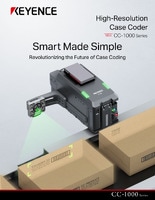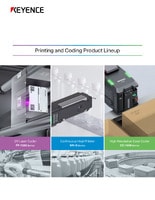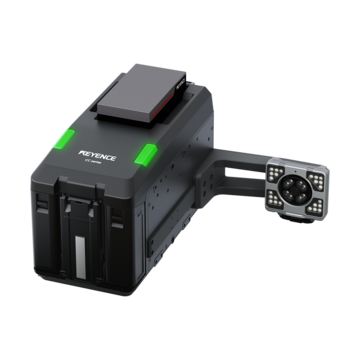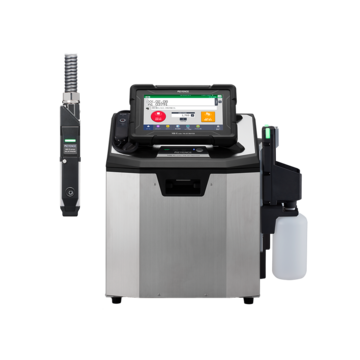Continuous Inkjet Printers / Case Coder
Materials and Products
Production Machines
Printing Applications
Direct Printing vs. Labeling on Cardboard: Which Is Better
Key Takeaways
- Direct printing doubles line throughput vs. label applicators and removes label handling steps.
- Switching to inkjet reduces consumable costs; studies show 50–60% savings per 1,000 prints.
- Modern inkjet (360 dpi, inspection cameras) achieves reliable, scannable barcodes on corrugated.
- Limitations: substrate contrast, placement, and some ANSI-compliance needs may still require labels.
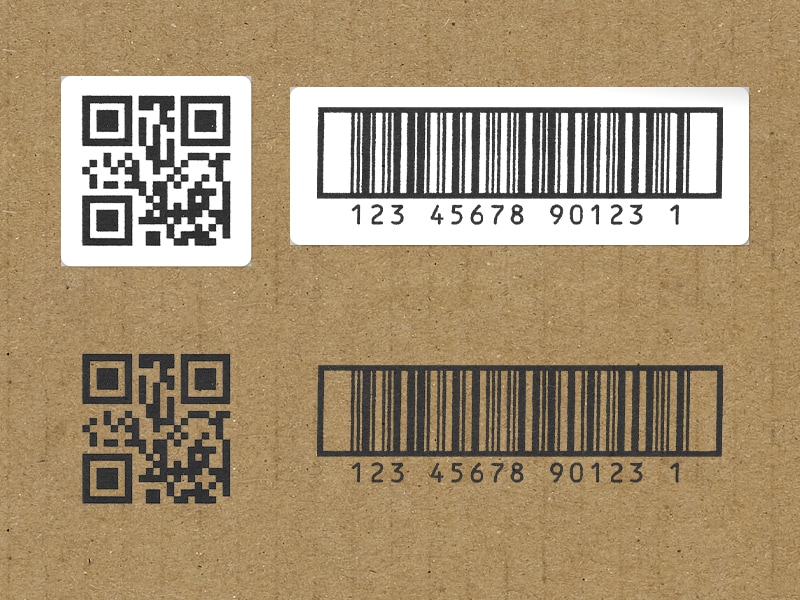
Whether in food, pharmaceuticals, or consumer goods, every product comes in a cardboard box that must carry not only goods, but the data that keeps supply chains moving.
Traditionally, companies relied heavily on box labeling to handle this task. But as demand for higher speed, lower cost, and greater sustainability grows, direct printing on cardboard has become a leading alternative. Both methods offer advantages, and the best choice depends on the balance between cost, speed, quality, and operational goals.
Why Direct Printing on Cardboard Saves Time and Money
One of the strongest arguments for direct printing on cardboard is speed. Labels must be printed, dispensed, and applied, adding multiple steps to production. By contrast, an inkjet printhead can apply codes directly to the box as it passes down the line, eliminating label handling and allowing faster throughput. In many applications, large character printing on carton surfaces can run at nearly twice the speed of label applicators.
The cost differences are equally compelling as labels carry ongoing consumable expenses in the form of substrates, adhesives, ribbons, and storage space. Direct printing cuts these out, leaving only ink as the recurring cost. Studies of carton operations often cite reductions of 50 to 60 percent per 1,000 prints when switching from box labeling to direct printing. For large facilities producing hundreds of thousands of cases annually, this shift translates to tens of thousands of dollars saved every year.
Direct printing not only reduces materials but also trims labor costs. Label jams, misapplied stickers, and manual rework all add downtime. Inkjet printing eliminates those points of failure. In environments where every second of production counts, the ability to cut steps without sacrificing legibility is a clear advantage.
We’re here to provide you with more details.
Reach out today!

The Durability Advantage of Direct Inkjet Printing on Cardboard
Durability matters as products travel through warehouses and distribution centers. Barcodes must scan correctly even after rough handling or exposure to dust. A white thermal-transfer label gives excellent contrast for barcode readers. Printing on corrugated boxes has caught up, though. The CC-1000 Series from KEYENCE runs at 360 dpi, which produces consistent, scannable codes.
One of the challenges in the past was that cardboard’s porous surface absorbed ink, lowering contrast. With advances in inks and printhead design, those limits are no longer a dealbreaker. High-resolution large-character printing on carton cases now achieves consistent scannability even on brown corrugated stock. Integrated inspection cameras can validate each mark in real time, reducing the risk of unreadable barcodes moving downstream.
Extended throw distance cuts down on the printhead colliding with the box, and cleaning cycles keep nozzles from clogging when lines run dusty or long. With inspection built in, weak marks get caught early, so direct printing stays consistent in places where labels once had the edge.
Cost Comparison: Labeling vs. Direct Printing on Cardboard
Breaking down costs highlights the contrast between the two methods. Box labeling involves the label material itself, ribbons for thermal transfer, and the labor to manage stock. Even when applied automatically, labels typically run three times the consumable cost of direct inkjet printing.
Printing carton labels also requires inventory management. Pre-printed labels can become obsolete if product data changes, leading to waste. Even with on-demand systems, labels bring ribbon costs and leftover stock. With direct printing on cardboard, those extras disappear, and the controller keeps message files ready to go, making changeovers faster and cleaner.
Some production lines report per-thousand print costs dropping from nearly ten dollars with labels to under four dollars with direct printing. For facilities producing hundreds of thousands of boxes, the savings of this compound into annual figures can exceed $40,000 or more.
Curious about our pricing?
Click here to find out more.

How Direct Printing Streamlines Your Packaging Process
Direct printing on corrugated cardboard removes the supply chain work that comes with labels. While labels must be sourced, stored, and tracked (adding complexity to supply chains), inkjet coding doesn’t require this. Instead, codes are applied digitally, reducing waste and freeing up operators from material handling tasks.
Large character printing on carton boxes, like those in food packaging, also allows for bigger print areas compared to labels; useful for logos, handling instructions, or compliance data. Unlike print-and-apply systems, inkjet heads can adjust font size or message length mid-run without interrupting production.
Labels bring extra material (adhesives, liners, backing) that stays with the carton. Those layers make recycling harder. Printing directly on cardboard avoids that problem, leaving the box clean and easier to reclaim. For plants chasing lower waste, cutting out adhesives is a simple gain.
Finally, with advanced inkjet controllers, multiple heads can be managed from a single interface. That means one operator can oversee several lines, cutting labor requirements and adding flexibility.
Best Practices for Printing on Cardboard with Inkjet Technology
Achieving consistent quality with direct printing requires attention to best practices. Substrate quality should be considered first. Smooth, uniform cardboard delivers better print contrast than rough or heavily recycled stock. Selecting the right ink formulation is also critical for balancing dry time and readability.
Printhead placement matters. Traditional systems required heads to be mounted very close to the surface, increasing the risk of collisions. Modern designs with longer throw distances reduce that risk and improve uptime. Integrating inspection technology helps maintain quality by flagging unreadable codes before products leave the line.
Regular maintenance routines, such as automated nozzle cleaning and scheduled fluid checks, help stabilize performance over long runs. Maintenance routines and modern printheads together deliver the crisp marks distributors expect. Labels once covered that gap, but direct printing now does the job on its own.
Challenges and Solutions with Direct Printing on Cardboard
Direct printing is not without challenges. Cardboard absorbs ink differently depending on its color and composition. This can reduce barcode contrast compared to the sharp black-on-white background of labels. Some customers may still prefer labels for compliance reasons, particularly where ANSI A-grade readability is mandated.
There are also placement limitations. While labeling can cover corners or wrap around edges, direct printing typically applies marks from the top or side only. For operations requiring dual-sided labeling on cardboard boxes, companies may need to configure multiple printheads or supplement with labels.
Modern case coders like the CC-1000 Series address many of these obstacles. High-resolution large character printing on carton surfaces improves scannability even on darker stock. Multi-sensor units react to line speed and product movement instead of locking into a fixed pattern. The printhead’s throw distance is longer, too, which helps cut down on clogs and head strikes, and, with inspection built in, weak codes get flagged right on the line instead of relying on a manual check later.
Optimize your packaging process with direct printing. Contact us to find out how!
Contact us to learn more about how our advanced technology can help take your business to the next level.
Contact Us
FAQs
How Does Direct Printing on Cardboard Compare to Labeling in Terms of Cost-Efficiency?
Direct printing eliminates label material, ribbons, and related storage, cutting costs by as much as 50 to 60 percent. Printing carton labels requires ongoing consumables, while direct coding uses only ink.
What Types of Ink Are Best Suited for Printing Directly on Cardboard?
Specialized inks formulated for porous surfaces provide the strongest results. These inks dry quickly and maintain contrast on corrugated stock.
Can Direct Printing on Cardboard Withstand the Wear and Tear of Shipping and Handling?
Yes. With high-resolution heads, long throw distances, and inspection systems, modern direct printing delivers codes that remain legible throughout logistics.
We’re here to provide you with more details.
Reach out today!

Related Downloads
Related Products
Applications
Materials and Products
- Glass Bottles
- Plastic Bottles/Containers
- Cans
- Wires, Cables, & Pipes
- Pouches
- Metal Parts
- Corrugate Boxes
- Packaging Film
- Kraft Packaging
- Folding Cartons
- Building Materials
- PCBs
- Cartons
- Pallets & Lumber
- Corrugate Trays
Production Machines
- Paper Bag Packaging
- Box Conveyor
- Automatic Palletizer
- Sealer/Taping Machine
- Bottle Filling Machine
- Flow Wrapper

